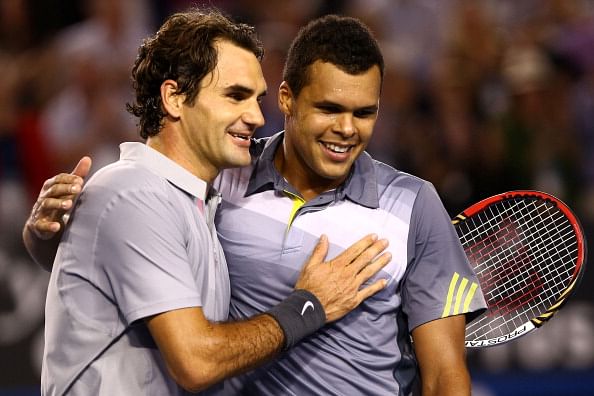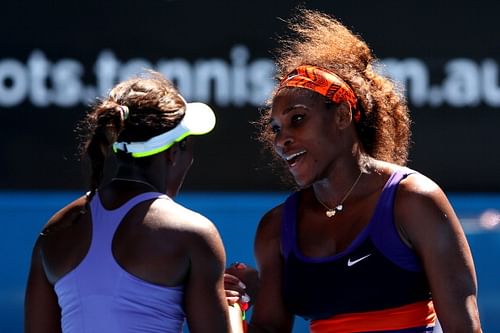
Federer forced to forage; Stephens sends Serena into a simmering fit

Federer and Jo-Wilfried Tsonga found humour even in the most exasperating of their exchanges.
On yet another humid day in Melbourne, two legends – both playing stellar tennis despite advancing years, were forced to look in the mirror and sweat over their growing wrinkles by their indomitable opponents. Both matches went the distance, but that is where the similarities ended.
Roger Federer could barely replicate his resplendent first week form, but somehow foraged his way to a laboured five set victory. On the other hand, Serena Williams could do no more than take cover inside her aching body even as the impressive teenager Sloane Stephens fought off her idol, and any lingering stage fright, to score a sensational come from behind victory over the hot favourite to launch herself into the big league of tennis. The world No.25 walked into Rod Laver Arena as a student to her classroom, and walked out of it as a decorated graduate intent on celebrating her arrival in the grandest possible fashion.
It was a day made memorable by the undying desire of an ageing Federer, who is steadfast in his refusal to vacate his place on the totem pole, and the blooming promise of a young teenager who many believe could fill the inescapable vacuum at the top of the women’s game. The contrast in the mood of the matches only added to the many layers of meaning that wrapped these contests in a shimmering coat that shall protect them in the shelves of memory, despite the fact that the quality of tennis was erratic – alternating between bouts of brilliance interspersed with tremulous malady. Where Federer and Jo-Wilfried Tsonga found humour even in the most exasperating of their exchanges, an annoyed Serena resorted to abusing her racket since she could not suffer the indignity of losing to a younger American for only the first time in her career.
At the turn of the previous millennium, Henry Ford created an assembly line that churned out an endless stream of cars in identical shape and colour. The model T was meant to be just an affordable car, but it emerged as a symbol of efficiency even as an entire civilisation turned it into a lesson in management to understand the benefits of repetition. In another life, Roger Federer must have belonged on such an assembly line. In defeating Tsonga, in an undulating contest that swung one way and then the other, the Swiss reached his 10th consecutive semi-final at the Australian Open and the 33rd of his illustrious career. Just to underline the unmatched consistency of the Swiss, no other male player in the history of the game has even come close to reaching at least five consecutive semi-finals in each of the four major tournaments, as Federer has done.
The world No. 2 had a smooth passage through to the quarters, arriving there without ever losing his serve. But Tsonga did so for the first time in this tournament, when he broke back in the sixth game of the first set to draw level at 3-3. And even though the Frenchman lost the first set tie-break on a solitary mini-break, he kept his spirit intact to take the second set and level the match. The third set too had an exchange of breaks, before Federer snagged yet another closely contested tie-breaker. Tsonga, as you will recollect, had upended the Swiss at the same stage in Wimbledon after being down by two sets. An inspired effort in the fourth drew Tsonga level again, only for the Frenchman to see his effort go in vain thanks to a measured effort from Federer in the final set.
It was Tsonga’s backhand that was doing the Frenchman’s bidding for much of the match, but it was the very shot that failed him at break point in the fourth game of the deciding set. In a match where breaks were exchanged often, Federer was tentative in the next game but did just enough to hold sway over Tsonga and inch ever so closer to a spot in the last four. Tsonga put up a spirited show to make the Swiss star earn every point from there, and even if he succeeded in saving as many as four match points, it was all he could do as Federer took the break to the bank and eventually earned the right to take on Andy Murray in the semi-finals on Friday with a hard earned 7-6 (4), 4-6, 7-6 (4), 3-6, 6-3 victory in three hours and 34 minutes.
Back to Serena – the storm that swept over Melbourne came without warning. Serena took control of her match in the eighth game, when the junior Williams won her first point off her opponent’s serve. Stephens fought gallantly to save two break points from 0-40 down, but succumbed on the third to trail 3-5. In fact Serena went on to win five straight games, as she took a set and a 2-0 lead over her young opponent. But that is where the match took its first detour, as the 19-year old broke serve to halt the Serena juggernaut and go all square at 2-2 in the second set. With the set on serve, Serena ran towards the net to pick up a drop shot and locked her back in the eighth game. It wasn’t as if Stephens needed an invitation, and the Florida native grabbed the opportunity with both hands to break ahead to 5-3. When Stephens squandered a set point in the next game, Serena took advantage to bring the set back on serve for a second time.

Stephens betrayed her age as she fought tooth and nail against her idol.
In the next game, Serena had game point to force a tie-breaker, but Stephens had other ideas. The 19-year old took to tennis relatively late – when she was 9 – but has been making amends by growing rapidly into a star firmly aware of her destiny. Showing typical resilience, Stephens saved a game point in the twelfth game before breaking serve to level the match one set each. In the final set, Serena, who hadn’t lost a match since the middle of August last year, took advantage of her nervous opponent to break in the seventh game to take control of the match. Yet again though, Stephens betrayed her age as she fought tooth and nail to take back the break in the very next game. Serena finally surrendered at the fourth break point to allow the younger American to level the match. A frustrated Serena fell behind 15-40 in the tenth game and Stephens wasted no time to put the elder woman out of her misery.
In the victories for Federer and Sloane, we see two ends of the same time warp – at one end is a timeless Swiss, who is doing all he can to suspend time and continue to do astoundingly well even at this ripened stage of his career. Federer, who won here last in 2010, could be competing for his fifth title in Melbourne if he succeeds in getting past Andy Murray on Friday. On the other end, we have Sloane. And she would only be too eager to turn the needle and move the women’s tour forward on the strength of a new generation of players, that include herself and others such as Laura Robson, Jamie Hampton, Madison Keys and Bojana Jovanovski who are all raw, young and eager to take over from the current generation.